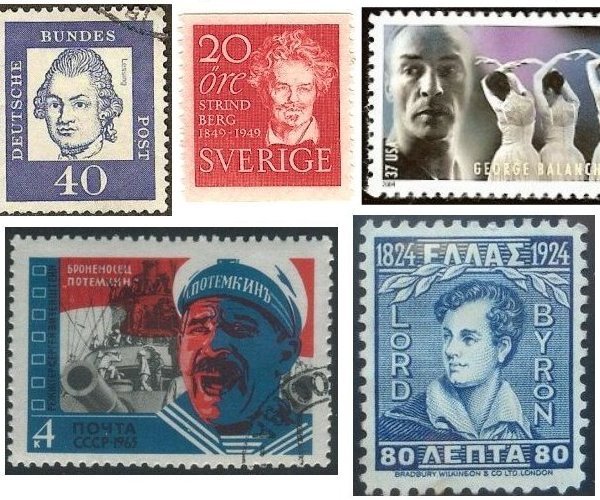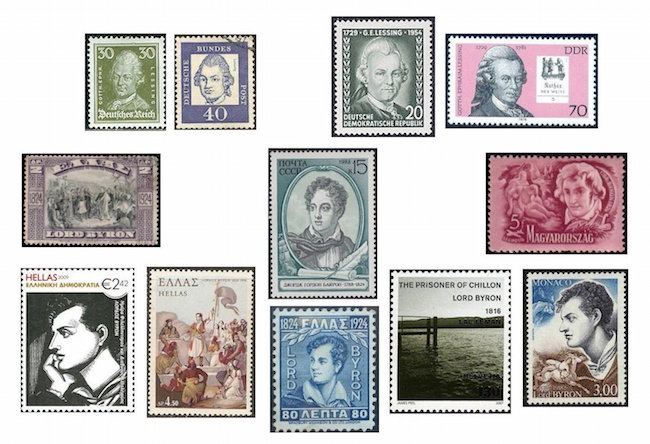The Arts on the Stamps of the World — January 22
An Arts Fuse regular feature: the arts on stamps of the world.

By Doug Briscoe
Three very great literary figures lead our piece on artists born on January 22: Gotthold Lessing, Lord Byron, and August Strindberg. But also born on this day were two very great filmmakers, D. W. Griffith and Sergei Eisenstein; the very great soprano Rosa Ponselle; the very great dancer and choreographer George Balanchine, and a couple of other guys.
I suppose that to most Americans, even quite literate ones, Gotthold Ephraim Lessing (22 January 1729 – 15 February 1781) is the least known (or at least least read) among today’s Top Three, but his influence on subsequent German literature and theater cannot be overstated. His innovations proclaim him history’s first dramaturge. Writing his first play in 1748, he went on to work as a reviewer, editor, secretary to a general during the Seven Years’ War, and librarian for the Duke of Brunswick. Having studied theology—along with medicine and philology—he was also a philosopher; his friendship with Moses Mendelssohn led him to publish articles on religious tolerance. These were banned, leading him to turn again to the theater with his masterpiece Nathan the Wise. This, too, was prohibited from performance during Lessing’s lifetime, being produced only in 1783. Lessing’s poems were an inspiration to a number of 18th-century composers, including Bach’s youngest son Johann Christoph Friedrich Bach. Haydn composed a vocal quartet, “Die Beredsamkeit”, and one of Beethoven’s Op. 52 songs (no. 6) sets a text by Lessing. I found four stamps for Lessing, two from West Germany (1926 and 1961) and two from East Germany (1954 and 1979).
George Gordon, Lord Byron (1788 – 19 April 1824) has been celebrated on stamps from a number of countries, Greece notably and not surprisingly among them. There seems to be no British stamp for him (nor for John Donne, who was also born on this date in 1573, d. 31 March 1631). Go figure. I was amazed at the number of well-known composers who have turned to Byron for inspiration. Besides Berlioz’s Symphony for viola and orchestra “Harold in Italy” and Tchaikovsky’s “Manfred” Symphony, there are Liszt’s Symphonic Poem #2, “Tasso, Lamento e Trionfo”, and Schumann’s choral work on Manfred. Some of the great many other composers who have set Byron’s words, either in the original English or in translation, include Samuel Coleridge-Taylor, David Diamond, Charles Gounod, Charles Ives, both Fanny and Felix Mendelssohn, Mussorgsky, Carl Nielsen, Rimsky-Korsakov, Ned Rorem, Augusta Read Thomas, and Hugo Wolf.
Most settings of the poems (yes, poems) of August Strindberg (1849 – 14 May 1912) are by Scandinavian composers, but there is also a song by Anton Webern (Op.12 no. 3). As for operas based on the plays, there are, among others, three treatments of Miss Julie by Ned Rorem (1965), William Alwyn (1977), and—more simply titled Julie—Philippe Boesmans (2005). Strindberg himself wrote a song, apparently his only composition, for his play Kronbruden (The Crown Bride), which was made into an opera in 1915 by Ture Rangström (first performed 1919). I must confess I was unaware that Strindberg also wrote several novels and pursued photography and painting, leaving some 117 known paintings, one of which, “The Inferno,” was chosen for a 1975 stamp, shown here to the right of the early 1949 set, while the 1990 stamp at left specifically focuses (ahem) on Strindberg as photographer.

Having already gone on at some length, and with a further four subjects ahead, I’ll skimp on the information about D. W. Griffith (1875 – July 23, 1948) and Sergei Eisenstein (22 January [O.S. 10 January] 1898 – 11 February 1948), who are likely very well known to readers of The Arts Fuse. The Griffith stamp was issued by the U.S. for his 1975 centennial, and the Soviet stamp of 1965 was not intended specifically for Eisenstein but rather as a tribute to the Soviet film industry, with two additional stamps remembering other celebrated movies.
Rosa Ponselle (January 22, 1897 – May 25, 1981) was born Rosa Ponzillo in Connecticut to Italian immigrant parents. She and her sister Carmela came to the attention of a voice teacher and agent who invited Enrico Caruso to his studio to hear them sing. Caruso was impressed with Rosa, and following an audition at the Met, she was offered a contract for the coming season. She had never performed on any opera stage before her debut as Leonora in La forza del destino on November 15, 1918, opposite Caruso. The resulting success launched her career, and she remained with the Met for nearly twenty years. With just four exceptions (three seasons at Covent Garden and one in Italy) she never sang outside the United States. She retired without fanfare in 1937 and in the late 40s began giving coaching and voice lessons. Some of the young singers she coached were Beverly Sills, yesterday’s birthday boy Plácido Domingo, Sherrill Milnes, and James Morris. I can’t resist copying three quotations cited (without sources) on Wikipedia: Walter Legge: “The most glorious voice that ever came from any woman’s throat.” Luciano Pavarotti: “The Queen of Queens in all of singing.” Maria Callas: “The greatest singer of us all.”
George Balanchine (January 22 [O.S. January 9] 1904 – April 30, 1983) was born Giorgi Melitonovitch Balanchivadze (of Georgian ancestry) in Saint Petersburg. His mother was a balletomane, and nine-year-old Giorgi auditioned for and was accepted into the Imperial Ballet School. He had already choreographed his first work by 1920. In the following year, he, his wife and two others defected to Paris, where Balanchine soon began working with Diaghilev, composers Debussy, Stravinsky, Ravel, Satie, and Prokofiev, and artists Picasso and Matisse. Unfortunately, Balanchine around this time suffered a knee injury that effectively put an end to his career as a star dancer. He helped found the Ballet Russe de Monte Carlo, a successor to Diaghilev’s Ballets Russes, in 1931 and formed the School of American Ballet in New York with Lincoln Kirstein in 1934. After a time in Los Angeles, Balanchine returned to New York, where, in 1955, he created his version of The Nutcracker, which has been performed every year since. He was married four times, always to ballerinas.

Arkady Petrovich Golikov (born 1904) adopted the pen name Arkady Gaidar. Already an ardent Bolshevik at 13, he was stabbed while distributing leaflets. Lying about his age, he fought in the Russian Civil War and was wounded again. He took a brief respite from physical danger by publishing his first novel at 22, though I assume the subject matter (write what you know) was physical danger, what with the title being In the Days of Defeats and Victories. He went on to write an early science-fiction novel, but was best known as an author of children’s books, the first of which appeared in 1926. His most famous work, Timur and His Squad (1940), inspired a nationwide movement among the Young Pioneers and other children’s groups. Along comes the Nazi invasion, and, not surprisingly, Gaidar is at the front, this time as a correspondent. When his unit was surrounded by German forces he joined the partisans as a machinegunner. He was killed in the fighting on 26 October 1941. Three Soviet biopics were made about him and two stamps issued.
Armenian composer, pianist, and teacher Arno Babajanian (January 22, 1921 – November 11, 1983) was born in Yerevan. He was an extraordinary child prodigy who caught the attention of Khachaturian and entered the Yerevan State Musical Conservatory at the age of seven. He studied further in Moscow and returned to Yerevan in 1950 to teach at the conservatory. His compositions include a Cello Concerto for Rostropovich and many popular songs, some of them written in collaboration with Yevgeny Yevtushenko and other prominent poets.
I was unable to locate any stamp reproducing the work of French painter Nicolas Lancret (22 January 1690 – 14 September 1743), but I’ll keep looking.
To my great dismay, France did not issue a centenary stamp for Henri Dutilleux (1916 – 22 May 2013) last year. Zut alors!
A graduate of the University of Massachusetts with a B.A. in English, Doug Briscoe worked in Boston classical music radio, at WCRB, WGBH, and WBUR, for about 25 years, beginning in 1977. He has the curious distinction of having succeeded Robert J. Lurtsema twice, first as host of WGBH’s weekday morning classical music program in 1993, then as host of the weekend program when Robert J.’s health failed in 2000. Doug also wrote liner notes for several of the late Gunther Schuller’s GM Recordings releases as well as program notes for the Boston Classical Orchestra. For the past few years he’s been posting a Facebook “blog” of classical music on stamps of the world, which has now been expanded to encompass all the arts for The Arts Fuse.
